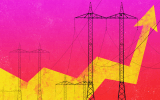


“Do me a favour and sleep on it.”
It’s a phrase we’ve all heard when confronting big decisions – should I quit my job? Break up with my partner? Move interstate?
Sleep, it turns out, might offer more than just rest. It could be the secret ingredient to solving complex problems and unlocking creative insights.
A study from the University of Hamburg offers compelling evidence that napping — specifically reaching a certain depth of sleep — can lead to real “aha” moments.
To explore the relationship between sleep and problem solving, researchers recruited 90 participants to complete a visual task involving tracking a series of dots on a screen.
The task appeared straightforward – respond to the dots using a keyboard – but the instructions omitted a hidden pattern that would make the challenge significantly easier.
After completing four sets of trials, participants were invited to take a 20-minute nap, during which their brain activity was monitored using an electroencephalogram (EEG).
When tested again post-nap, a striking 70.6 per cent of participants experienced a breakthrough, discovering the trick that had eluded them before.
While all groups showed some improvement after the break, the difference in insight was stark.
A remarkable 85.7 per cent of participants who entered N2 sleep — the first true stage of deeper sleep — experienced a moment of clarity. This compares to 63.6 per cent of those who only reached light N1 sleep, and just 55.5 per cent of those who stayed awake.
“It’s really intriguing that a short period of sleep can help humans make connections they didn’t see before. The next big question is why this happens,” said co-author Nicolas Schuck, an expert in cognitive neuroscience.
“We hope that our discovery that it may be linked to the EEG spectral slope is a good first lead.”
The “spectral slope” is a relatively new EEG measure, linked to brainwave activity during different sleep stages. In this study, researchers found that a steeper spectral slope — associated with deeper sleep — correlated with greater likelihood of an “aha” moment.
“I find the link between the spectral slope steepness during sleep, aha moments after sleep and the down regulation of weights, which we identified as crucial for aha moments in our previous computational work, very exciting,” said Anika Löwe, an expert in sleep neuroscience.
The results reinforce something many people have experienced anecdotally: The creative clarity that sometimes follows a nap.
“I think a lot of us have made the subjective experience of having important realisations after a short nap,” said Löwe.
“It’s really nice to not only have data on that, but also a first direction of what processes are behind this phenomenon.”
So, the next time you’re faced with a complex choice or creative block, you might do well to follow the age-old advice: Sleep on it. Science says it really might help.
This article first appeared in Cosmos Magazine. Read the original here










